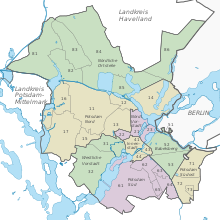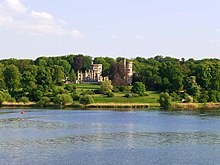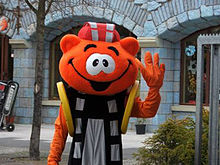Babelsberg
|
Babelsberg
State capital Potsdam
Coordinates: 52 ° 23 ′ 33 ″ N , 13 ° 6 ′ 44 ″ E
|
|
|---|---|
| Height : | 36 m above sea level NN |
| Area : | 9.7 km² |
| Residents : | 25,084 (Dec. 31, 2020) |
| Population density : | 2,586 inhabitants / km² |
| Incorporation : | April 1, 1939 |
| Postal code : | 14482 |
| Area code : | 0331 |
Babelsberg is the largest part of the municipality of Potsdam , into which the formerly independent city was incorporated in 1939. The city administration divides it into the statistical districts Babelsberg North, Babelsberg South and Klein Glienicke . Together they have around 25,000 inhabitants (as of 2020). Babelsberg has significance beyond the borders of Potsdam through the Babelsberg Park and the Babelsberg Palace located in it .
Worldwide Babelsberg is a synonym for the Babelsberg Media City , an area within the district in which the Studio Babelsberg , the film park Babelsberg , the headquarters and studios of Radio Berlin-Brandenburg (RBB) , the film university Babelsberg Konrad Wolf , the Babelsberg Film School (bfg), UFA and numerous other institutions and companies in the media industry.
history
Neuendorf and Nowawes from its foundation to 1939
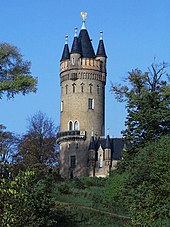
The first settlement in the area of today's Potsdam district of Babelsberg was the village of Neuendorf (Slavic "Nova Ves") located on an elevation in the Nutheniederung , which explains the later name Nowawes . The place was south of a 77 meter high elevation, the Slavic Buberow ("place where there are beavers") was called, from which the German name Baberberg and finally Babelsberg . Neuendorf was a round square village with a church on the meadow . The village mentioned in the land register of Emperor Charles IV of 1375 was pledged several times and badly damaged in the Thirty Years' War .
It was not until 1750 that new settlers came to the area: Protestant religious refugees from Bohemia who moved to Protestant Prussia because of the strict Counter-Reformation under Maria Theresa . Friedrich II had a settlement built on the periphery of two royal highways near Neuendorf . The immigrant Bohemian weavers called their colony, which was laid out next to Neuendorf, Nowawes (Bohemian translation of Neuendorf ). Both places remained independent communities for over 150 years: Neuendorf with its German farmers and Nowawes with its mainly Bohemian weavers.
Babelsberg Palace was built for the Prussian Prince Wilhelm (later Kaiser Wilhelm I ) from 1833 . This was named after the hill on which it stands. In 1862 Neuendorf and Nowawes got a common train station - initially for the royal court trains, later also for regular passenger traffic - today 's Babelsberg S-Bahn station . From 1871 onwards, the new villa colony Neubabelsberg was built at the foot of the Babelsberg in the municipality of Klein Glienicke between Nowawes and the Griebnitzsee .
In 1907, the two communities Neuendorf and Nowawes, whose population had grown rapidly in the course of industrialization, united to form the rural community of Nowawes. In 1924 Nowawes was granted city rights , and three years later the city had a population of over 27,000. The community of Klein Glienicke was renamed Neubabelsberg in 1925.
Nowawes and the community of Neubabelsberg were merged on April 1, 1938. The Bohemian name "Nowawes" was changed by the National Socialists . The city was named Babelsberg and was the largest city in the Teltow district until it was incorporated into the independent city of Potsdam on April 1, 1939 and has since formed the largest district there.
Babelsberg as a district of Potsdam (since 1939)
From July 1, 1944 to March 1945, there was a satellite camp of the Sachsenhausen concentration camp in Babelsberg . In addition, around 7,000 forced laborers , mainly from Eastern Europe, had been working in Babelsberg companies since 1941 . They were housed in barracks camps under degrading conditions. At the end of the Second World War , the communists Heinrich Eichler and Alfred Lehnert, with the support of Soviet forced laborers, secretly removed an anti-tank barrier on the road from Güterfelde to Babelsberg, which made it easier for the Red Army to take the place without a fight .
As part of the Potsdam Conference from July 17 to August 2, 1945, Josef Stalin , Harry S. Truman and Winston Churchill took up residence in the villa colony of Neubabelsberg . Even after the conference, parts of Babelsberg remained in Soviet hands. The headquarters of the high command of the group of Soviet occupation troops in Germany was located at Griebnitzsee station until probably 1951/52 . Potsdam-Babelsberg had a direct border with West Berlin , which is why parts of the Berlin Wall also ran into Babelsberg territory. Noteworthy is the western semi-enclave of Steinstücke , which was enclosed by the Babelsberg area as a real exclave during the division of Germany until a territorial exchange in 1971, but it belonged to West Berlin.
From 1953 to 1990 Babelsberg was the seat of the Academy for Political Science and Law of the GDR .
Economic history
To the northeast of the old village of Neuendorf, Frederick the Great founded the Nowawes weaver and spinner colony ( Weberviertel ) in 1751 for evangelical refugees from Bohemia . You should process cotton and produce silk. In the second half of the 19th century Nowawes developed into an industrial location. The textile industry , which was mainly developing on the Nuthe and on the Berlin – Potsdam railway line , soon led to a merger with the old village of Neuendorf.
With industrialization in the greater Berlin area in the second half of the 19th century, branch plants also settled in the surrounding area. In 1899 , the Berlin “ Märkische Lokomotivfabrik Orenstein & Koppel OHG ” established a branch with an extensive boiler forging facility near the Drewitz train station on Neuendorfer premises . Under the name "AG für Feld- & Kleinbahnen -bedarf, formerly Orenstein & Koppel", the plant was a large locomotive manufacturer for field railroad and construction locomotives as well as for armaments such as mounts for anti-tank guns until the Second World War. As a result of the persecution of the Jews, the heirs of the locomotive factory were expropriated by the National Socialists and in 1940 the company was renamed "Maschinenbau und Bahnbedarf AG". Other companies in Babelsberg, such as Arado Flugzeugwerke , also mainly produced armaments during this period.
Locomotive construction was resumed from 1947, and in 1948 it was renamed “ LOWA Lokomotivbau Karl Marx Babelsberg ” (LKM). Locomotive construction was discontinued until 1976. At the same time, the production line was fundamentally changed, and the plant was given the new name “VEB Kombinat Luft- und Kältetechnik, Betrieb Karl Marx, Babelsberg”. At the same time, the mechanical engineering company Karl Marx Babelsberg , which was part of the TAKRAF combine , was established. He manufactured truck cranes based on the IFA W50 .
Today there is a business park on the industrial site.
Tourist Attractions

In addition to Babelsberg Castle, Babelsberg Park and the Flatow Tower, Babelsberg has a number of sights and a great variety of architecture. The brick Gothic style of Nowawes Town Hall, which was built in 1898/1899 according to plans by Otto Kerwien and has shaped the town center ever since , has been used as a cultural center since 1956. Equally striking is the brick building of the Bertha von Suttner grammar school to the south , which was built in 1911 as the Althoff Realgymnasium (Beethoven school during the GDR era) and is quite unique in its overall form.
Many buildings from the Wilhelminian era have been preserved throughout the district, encompassing all styles of historicism that was dominant at the time . After the end of the GDR, many gaps between the Wilhelminian-style buildings were filled with partly post-modern new buildings, the shape and facade design of which were adapted to the historic residential buildings.
All over Babelsberg, but especially in the Weberviertel and on Karl-Liebknecht-Straße, you can find old weaver houses. Mainly in Südbabelsberg there are typical buildings of the classical modern , which meanwhile mostly have been renovated.
In Neubabelsberg there are well-known villas of the former resident personalities such as Stalin , Churchill and Truman , the Gugenheim family, but also of film stars such as Marika Rökk and others. There are also buildings ranging from modern villas to isolated half-timbered houses to single-family houses from the GDR era.
In addition to the Friedrichskirche on Weberplatz, built by Johann Boumann in simple baroque forms in 1752/1753, three churches in Babelsberg (Old Neuendorfer Church , Oberlink Church , Klein-Glienicke Chapel) date from the Neo-Gothic period . The St. Antonius Church is a modern church from 1934; since 1942 the interior has been dominated by the "Adoration of the Lamb", a monumental altar mosaic by the artist Egbert Lammers .
The Alte Brauerei Potsdam was named Monument of the Month in 2014.
Media location
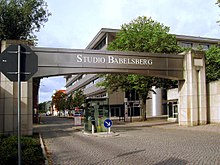
The then city of Nowawes - later Babelsberg - was a well-known film location as early as the 1920s. Many of UFA's German film classics were shot in the Babelsberg film studios founded in 1911 . From 1933, the National Socialists, under the leadership of the Reich Minister for Public Enlightenment and Propaganda Goebbels, used the UFA studios for their propaganda purposes . Soon the “patron of German film” was ironically referred to as “Bock von Babelsberg” because of his numerous love affairs . On April 24, 1945, the Red Army occupied the Babelsberg film grounds.
During the GDR era, the state film company DEFA took over the studio premises and produced numerous films; Babelsberg was popularly known as "Honnywood" (the link between Hollywood and Erich Honecker ).
After the political change , the media city of Babelsberg was built with enormous investment . The film studio now known as Studio Babelsberg is now the oldest and largest studio complex in Europe. TV series and soap operas such as Gute Zeiten, Bad Zeiten or Schloss Einstein as well as the major national and international cinema productions such as Sonnenallee and Boxhagener Platz , Der Pianist , Inglourious Basterds or Operation Walküre - The Stauffenberg Assassination are realized here. In 2007 alone, nine Hollywood productions were made here.
In addition to the Babelsberg studio, the media city of Babelsberg, among others, is located on the 46 hectare site . the headquarters and production site of the RBB (Rundfunk Berlin-Brandenburg, formerly ORB ) with several radio and television studios, the UFA film production company , the German Broadcasting Archive (DRA) , the Babelsberg Konrad Wolf Film University , which trains young film talent , the Babelsberg Film High School, the seat of the German Film Orchestra Babelsberg , as well as numerous production companies, agencies and smaller media companies for film and television. A total of more than 130 companies are based in the media city of Babelsberg .
With the Babelsberg film park , the district also has an amusement park dedicated to film and television. In addition to the rides, those interested in film can see the original props, backdrops and stories from over 100 years of film in Babelsberg, live during the production of episodes of the children's television series Our Sandman and soap opera Good times, bad times to watch, as well as guided tours through the neighboring studio area experience with.
Babelsberg is also home to the two Potsdam film festivals, the renowned Sehsuchten on the campus of the film university and the media city, as well as the Potsdam International Film Festival at the Babelsberg Thalia cinema.
traffic
Babelsberg has three train stations, two of which are on the main line and are served by the S7 S-Bahn line : Griebnitzsee and Babelsberg . The Griebnitzsee station is also connected to the regional train lines RB 21 and RB 22. The regional express RE 7 and the regional train line RB 33 run from Medienstadt Babelsberg station. Babelsberg is connected to the Potsdam tram at several stations . Lines 94 and 99 stop there.
science
Babelsberg has three locations of the University of Potsdam , the headquarters of the Film University Konrad Wolf , the Leibniz Institute for Astrophysics Potsdam (AIP), the Babelsberg location of the German Broadcasting Archive (DRA), the Babelsberg Film High School and the Hasso Plattner Institute (HPI) ).
Museums
- Berlin S-Bahn Museum (Rudolf-Breitscheid-Straße 203) (1996 to 2019, then moved to Berlin)
- Nowaweser Weberstube (Karl-Liebknecht-Straße 23)
- Anesthesia and pain therapy museum (Karl-Marx-Straße 42)
- German Broadcasting Museum (in the building of the German Broadcasting Archive: Marlene-Dietrich-Allee 20)
- Babelsberg Castle and Flatow Tower (in Babelsberg Park)
Sports
Babelsberg is the seat of the soccer clubs SV Babelsberg 03 , FSV Babelsberg 74 and SV Concordia Nowawes 06 . The 1. FFC Turbine Potsdam women's soccer club also plays its games in the Karl Liebknecht Stadium in Babelsberg .
miscellaneous
The Oberlinhaus is located in Potsdam-Babelsberg , an independent diaconal service company with care and educational offers as well as facilities for school, professional, medical and social rehabilitation.
literature
- Wolfgang Berschein, Michaela Schubert: Potsdam-Babelsberg - the special travel guide. Babelsberg & Hollywood, villa colony, park, castle, media city. How it was and is. Wolbern-Verlag, ISBN 3-9808472-2-5 .
- Filmmuseum Babelsberg: Babelsberg - Faces of a film city. Henschel Verlag, Berlin, ISBN 3-89487-508-9 .
- Herbert Knoblich, Almuth Püschel et al .: Neuendorf - Nowawes - Babelsberg. Stations of a district. Geiger-Verlag, Potsdam 2008, ISBN 978-3-89570-653-0 .
- Karin Carmen Jung: The Bohemian Weavers' Colony Nowawes 1751–1767 in Potsdam-Babelsberg. Structural and urban development. Haude and Spener , Berlin 1997, ISBN 3-7759-0407-7 .
- Paul Sigel, Silke Dähmlow, Frank Seehausen, Lucas Elmenhorst: Architectural Guide Potsdam. Dietrich Reimer Verlag, Berlin 2006, ISBN 3-496-01325-7 .
- Hermann Grampp: Film City Babelsberg . In: Die Mark Brandenburg , Issue 74, Marika Großer Verlag, Berlin 2009, ISBN 978-3-910134-12-6 .
- Babelsberg. Then and now . Culturcon / Märkische Oderzeitung , 2011, ISBN 978-3-941092-77-8 .
Web links
Individual evidence
- ↑ Population: residents by district. December 31, 2019, accessed January 12, 2021 .
- ↑ Babelsberg. In: Literaturport , Literarisches Colloquium Berlin 2015.
- ↑ Ursula Höntsch: The Babelsberg anti- tank barrier . In: The Zero Hour , Berlin 1966, p. 146.
- ^ The Soviet High Command in Potsdam-Babelsberg . In: Berlins Taiga - Your companion for excursions into Soviet history . July 14, 2017 ( berlinstaiga.de [accessed July 14, 2017]).
- ↑ Studio size of Studio Babelsberg ( Memento from November 25, 2010 in the Internet Archive ), accessed on December 2, 2010
- ^ (Co) productions of Studio Babelsberg ( Memento from November 25, 2010 in the Internet Archive ) accessed December 2, 2010
